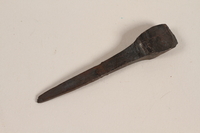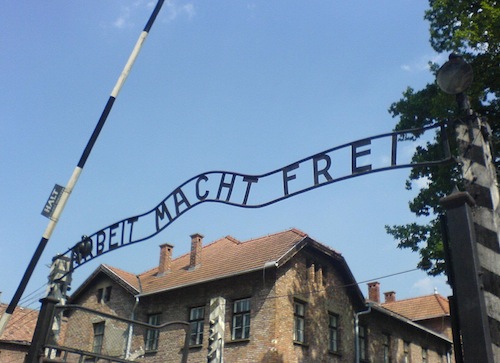There’s no way to explain what Auschwitz was. “The nightmare of humanity” probably sums it up. Estimates are that a million people died of disease and starvation or were cruelly executed there; it was the end point in a massive deportation effort aimed at ridding Europe of Jews, homosexuals, Gypsies and Jehovah’s Witnesses, along with political prisoners from many nations, simply by exterminating them.
But I’ve always wanted to mention a very famous, but also very forgotten, blacksmith who forged one of the world’s most lasting symbols of suffering and evil. I'd like you to meet Jan Liwacz, the blacksmtih of Auschwitz. And then there are the horses...
Early in the war, some blocks of Auschwitz’s horse stables were famously converted to house thousands of prisoners at a time in the new prison complex; they lived stacked in bunks in the stalls. Some were on their way to a quick death. Others died more slowly, of disease or starvation. Still others became forced laborers at local factories and farms or in the camp. Many died on the job.
And some were put to work at one of camp's smithies.
There are stories of prisoners being so weak that they couldn't lift the big bars of fabrication steel from the forges to carry them to the drop hammers. They didn't have the strength to grasp the glowing bars tightly in their tongs. Once dropped, the steel cooled and had to carried not on to the hammer but back to the forge, to be heated again.
One day, Jan was given an assignment that would go down in history. He was told to forge together the letters of a slogan. The words would form an arch over the entrance to the main Auschwitz facility.
Arbeit macht frei.
It is still there today, where it was welded into place so long ago, marking the entrance to the memorial site and museum.
Translated to English, it means, “Work will make you free.” The words hung above gates at other Nazi prison and concentration camps, as well. What did it mean? Were they lying to the inmates on arrival, since very few survived, once they passed under those words, let alone were set free?
If prisoners worked hard enough, they might not be free of prison life, but, from the Nazi point of view, work was a way for the prisoners to repay their debt to humanity for being inferior or evil human beings just because of their religion, their ethnicity or their sexuality.
And work they did.
 |
| A lamp at Auschwitz credited to Polish prisoner blacksmith Jan Liwacz. (Public domain image) |
What you may not have noticed about the 16-foot sign is Jan’s subtle act of resistance. Precision is critical in blacksmithing, especially when making something as important as the entry sign to a huge prison complex. And the Nazis would have been very precise taskmasters. Jan would have to be very careful about letter spacing, there was no room for error. And the guards were surely watching his every move.
But Jan thought he could pull off a little trick as he welded it all together.
Though it is hard to pick out at first, the letter “B” in the sign is welded in upside down, with the larger loop on the top instead of the bottom. A skilled smith wouldn’t weld it like that. But Jan did.
Once you notice it, your eye will go to the "B" every time you see the sign. It was a typographic insult to his captors, who couldn't exactly take it down and re-weld it, without the skill of the very man who'd pulled off the stunt.
Jan must have been smiling to himself, all the while wondering if anyone would ever notice his small act of defiance. He obviously didn't brag about it, or he'd be much more famous and have had a film made and a novel written about him by now.
In an interview with the Auschwitz Museum, many years later, he recalled how the prisoners felt about their small act. "It (was a) kind of malice, which gave us a little satisfaction," he said.
Little did Jan know that his sign would become known around the world and down through history, even if most people completely miss his symbolic act.
The sign was stolen from the camp in 2006, but it was recovered. A duplicate has been made, just in case, and the sign is occasionally taken down for refurbishing. All work on the sign is done on site, in one of the Auschwitz Museum smithies. Like so many of the people who entered through this gate, it will never leave the place it came to symbolize.
Sadly, Jan seems to be lost to history. It is time to change that.
 |
| This photo shows the sign on a gray day, long ago. The air appears to be filled with smoke. |
What else do we know about Jan, otherwise known as Inmate #1010? Records show that while he was at Auschwitz, he spent five weeks in the famous solitary confinement block #11. The prison cells were called “upright”. They were tiny cubicles too small for a person to lie down. They could only stand or kneel. In Jan’s case, he couldn’t lie down for five weeks. The reason for his solitary confinement is not in the brief biographical notes that exist about him, only that he served the time.
Perhaps it was because someone noticed the letter “B” in the sign, and knew that someone as skilled as he must have erred intentionally.
Before the end of the war, Jan was transferred to a concentration camp in Ebensee, Austria. His camp was liberated by US troops of the 3rd Cavalry Reconnaissance Squadron; ironically, he was just 40 miles from the Spanish Riding School's wartime encampment at St Martin, where General George S. Patton watched them perform before deciding to authorize a rescue mission to free the School's Lipizzaner mares being held by the Germans in what was then Czechoslovakia.
Once free, Jan joined up with a friend from the Polish Resistance and a former fellow Auschwitz prisoner. Together, they walked hundreds of kilometers across Austria and Slovakia toward a life under communism in Poland. Jan got a job, working for a German blacksmith and later, teaching ironworking skills. He never stopped forging.
In a memoir, his granddaughter said that he returned to Auschwitz once every year, and took his family. She said he walked slowly through the places he had known, and told his children his story, and the story of the sign. He stayed in touch with his former prison friends who also survived.
Jan died in 1980, at the age of 82. He is was buried in Bystrzyca Kłodzka, Poland where the town center's Holy Trinity sculpture is surrounded by a fence he forged.
The smell of burning hoof
What about horseshoeing at Auschwitz? I would love to hear from anyone who has references about horseshoeing there.
But then, of course, there is the legendary hoof smoke of Auschwitz.
 |
A handmade winter-head
horseshoe nail made by a gypsy prisoner at Auschwitz.
(US Holocaust Memorial
Museum collection) |
The US Holocaust Memorial Museum has a horseshoe and some hand-forged nails made by one of the many Gypsy prisoners.
Most people don't like the smell of burning hooves. But the hoof smoke legend of Auschwitz is the worst burning hoof smell in history.
It is often asked how the people in the surrounding communities could not have known about the mass cremations going on at Auschwitz. Many claimed to have no knowledge, to not have heard or seen or smelled anything.
No smell? There was a stench. Some local people later admitted the smell was so bad they lived with their windows closed, even in summer. The camp's official explanation was that the local people should ignore it, that the smell was from the farrier shops. They had a lot of horses to shoe.
As history advanced, holocaust deniers like author Christopher Thies, a German soldier stationed at Auschwitz, insisted in war crime trials that there was no mass cremation system, and that the smell some local people mention was simply the acrid smell of burning hooves from the forges, because the camp had so many horses needing shoes.
by Fran Jurga
Never forget "the story behind the story" of the Auschwitz gate sign. Never forget the Holocaust. Thank you for sharing this story via social media (you can use the little symbols below to easily share) so more people can learn about Jan and the evil irony of Auschwitz's "hoof smoke".
Jan's biography is no longer on the web, but you can access it through the Wayback Machine.
The BBC published one of the few articles in English mentioning Jan Liwacz: "Auschwitz's sign of death and defiance"
Auschwitz Study Group
HT to The Consummate Dabbler, an interesting website where my quest began to learn more about Jan Liwacz...only to find out that, without learning Polish, I wasn't going to get very far. But, thank you!
For more on farriers at Auschwitz...meet me at the library.
© Fran Jurga and Hoofcare Publishing; Fran Jurga's Hoof Blog is the news service for Hoofcare and Lameness Publishing. Please, no re-use of text or images on other sites or social media without permission--please link instead. (Please ask if you need help.) The Hoof Blog may be read online at the blog page, checked via RSS feed, or received via a headlines-link email (requires signup in box at top right of blog page). Use the little envelope symbol below to email this article to others. The "translator" tool in the right sidebar will convert this article (roughly) to the language of your choice. To share this article on Facebook and other social media, click on the small symbols below the labels. Be sure to "like" the Hoofcare and Lameness Facebook page and click on "get notifications" under the page's "like" button to keep up with the hoof news on Facebook.
Follow Hoofcare + Lameness on Twitter: @HoofBlog
Read this blog's headlines on the Hoofcare + Lameness Facebook Page
Disclosure of Material Connection: The Hoof Blog (Hoofcare Publishing) has not received any direct compensation for writing this post. Hoofcare Publishing has no material connection to the brands, products, or services mentioned, other than products and services of Hoofcare Publishing. I am disclosing this in accordance with the Federal Trade Commission’s 16 CFR, Part 255: Guides Concerning the Use of Endorsements and Testimonials in Advertising.



